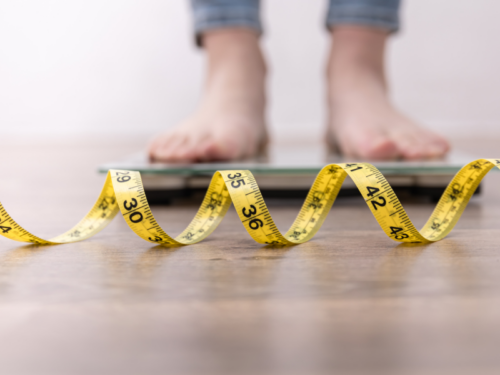
Table of Contents
The Difference Between Anorexia and Bulimia, According to Therapists

Written By: Sarah Fielding

Clinically Reviewed By: Jordanne Greenberg
May 12, 2025
6 min.
Learn about the difference between anorexia and bulimia symptoms and treatments.
Learn more about our Clinical Review Process
Table of Contents
Many people have a complicated relationship with food and their body image. Sometimes, this can lead to changes in eating habits or disordered eating. Other times, it becomes an even larger issue, developing into a diagnosable eating disorder — life-threatening conditions that often co-occur with other mental health issues, such as anxiety or depression. “Eating disorders are not choices,” explains Charlie Health Contemplative Practitioner Tairesha “Sunflower” Flemister, LMSW. These conditions can develop as a result of environmental triggers, traumatic experiences, chemical imablances and metabolic dysfunction.
Two of the most common eating disorders are anorexia and bulimia. People might have an image of what these disorders look like, but the conditions vary widely and can affect anyone—often in unexpected ways. As Charlie Health Group Facilitator Bree Williams, LPCA, puts it: “Eating disorders do not have a ‘look.’ They affect people across all races, genders, body types, and backgrounds.” Read on to learn more about anorexia vs bulimia, from their symptoms to treatment options.

Start healing from anorexia or bulimia with virtual care that meets you where you are
Connect with others who understand and get support from experts who care.
Anorexia vs bulimia: Causes & symptoms
Eating disorders are serious conditions that affect millions of people across the U.S. A report from Harvard, the Academy for Eating Disorders (AED), and Deloitte Access Economics found that almost 1 in 10 Americans (9%) will experience an eating disorder in their lifetime — amounting to roughly 28.8 million Americans.
Among the most well-known eating disorders are anorexia nervosa and bulimia nervosa. According to the National Institute of Mental Health (NIMH), anorexia is “characterized by a significant and persistent reduction in food intake leading to extremely low body weight.” By contrast, bulimia occurs when a person is “binge eating followed by a type of behavior that compensates for the binge, such as purging, fasting, or excessive exercise,” the NIMH reports.
While they share some overlapping features, each condition has unique symptoms, causes, and risks.
Causes of anorexia vs causes of bulimia
The causes of anorexia and bulimia are complex and often rooted in a mix of psychological, environmental, and biological factors. While each disorder has distinct features, both are often fueled by struggles with control, self-worth, and emotional pain.
Causes of anorexia
Causes of bulimia
Anorexia is often driven by a need for control, distorted body image, and underlying emotional or psychological distress.
Bulimia may develop as a way to manage overwhelming emotions, body image struggles, or trauma through cycles of bingeing and purging.
Causes of anorexia
Anorexia has a range of possible causes. According to Flemister, anorexia can develop due to environmental, psychological, and genetic factors — or some mix of the three. These causes include:
- Fear of gaining weight
- A distorted body image
- Perfectionism
- High sensitivity
- A need for control
- Trauma
- Bullying
- Family or societal pressures
“Anorexia is not about vanity — it’s often about trying to feel safe, worthy, or in control in a world that feels overwhelming,” says Williams. Charlie Health Group Facilitator Clary Figueroa, MSW, seconds this. “Sometimes, it can feel like controlling food or your body is the only way to feel in control when life feels overwhelming.” People may also develop negative core beliefs as a result of traumatic life experiences, leading one to feel unworthy of nourishment and restrict food intake as an attempt to self-punish for feelings of shame or guilt.
Causes of bulimia
According to Williams, someone might develop bulimia if they:
- Use food to cope with intense emotions, like sadness, anxiety, or loneliness — then purge to ‘undo’ the binge
- They struggle with body image but don’t have the rigidity of anorexia, leading to cycles of loss of control followed by extreme guilt
- They feel pressure to meet unrealistic body standards, especially in competitive environments like sports or modeling
- They’ve experienced trauma or emotional neglect and use food and purging as a way to soothe or punish themselves
Symptoms of anorexia vs symptoms bulimia
While anorexia and bulimia are both eating disorders, they often show up in different ways—physically, emotionally, and behaviorally.
Symptoms of anorexia
Symptoms of bulimia
Anorexia is marked by extreme restriction, dramatic weight loss, and an intense fear of gaining weight, often paired with distorted body image and rigid food behaviors.
Bulimia involves cycles of bingeing and purging, often accompanied by weight fluctuations, shame, and physical signs like dental erosion or swollen cheeks.
Anorexia symptoms
Anorexia can present differently in each individual. According to the National Eating Disorders Association (NEDA), anorexia symptoms include:
Emotional and behavioral symptoms
- Intense fear of gaining weight despite being underweight
- Refusal to eat certain foods or elimination of entire food groups
- Distorted body image and frequent comments about feeling “fat”
- Rigid food rituals (e.g., excessive chewing, eating in a specific order)
- Dressing in layers to hide weight loss or stay warm
Physical symptoms
- Dramatic weight loss
- Feeling cold all the time
- Thinning hair and nails
- Loss of menstrual period (amenorrhea)
- Muscle weakness
Bulimia symptoms
According to NEDA, bulimia symptoms include:
Emotional and behavioral symptoms
- Recurring episodes of binge eating followed by purging (vomiting, laxatives, excessive exercise)
- Feeling out of control during binges, despite feeling full
- Preoccupation with body shape and weight, which leads to cycles of restriction and bingeing
- Use of mouthwash, mints, or gum excessively to mask purging
- Withdrawal from friends and usual activities due to shame
Physical symptoms
- Noticeable weight fluctuations
- Cuts or calluses on fingers from self-induced vomiting
- Dental erosion or sensitivity from frequent vomiting
- Swollen cheeks or jaw area
- Dehydration or electrolyte imbalances
Treatment for anorexia and bulimia
Eating disorder treatment requires a tailored and thorough approach. “Both anorexia and bulimia require comprehensive treatment that addresses the physical, emotional, and psychological aspects of the disorder,” says Flemister. “While anorexia and bulimia share some similarities, they manifest in different ways and require personalized care. Early intervention dramatically improves recovery outcomes, and healing is absolutely possible with the right support.”
Here are the mental and physical health treatment options for these health conditions.
1. Medication
According to NEDA, anxiety disorders, depressive disorders, mood disorders, and substance use disorders all frequently co-occur with eating disorders. “Medication may help with anxiety, depression, or other challenges that go along with the eating disorder,” says Figueroa.
If disorded eating is related to an underlying mental health condition like anxiety, depression, OCD or PTSD, medication targeted at treating these symptoms may lead to a reduction in symptoms of co-morbid eating disorders.
2. Medical monitoring
Treatment for an eating disorder must also involve a holistic health approach . “Anorexia and bulimia can cause serious health issues, such as heart complications, electrolyte imbalances, menstrual irregularities, so regular medical check-ins are vital,” says Williams.
3. Dietitian
Working with a dietitian can be an essential step in eating disorder recovery. They can help you work through fears about certain foods, listen to hunger and fullness cues, and create a balanced, healthy diet, says Williams.
4. Support systems
Any form of support you can find while navigating an eating disorder can make a world of difference. Support can come in many forms, including family members, friends, peers, and group sessions.
These supports can also help you navigate necessary changes and serve as a judgment-free zone. “Promoting body acceptance, reducing stigma, and challenging harmful societal messages around food and weight are crucial steps toward prevention and collective healing,” says Flemister.
5. Therapy
Therapy can be a critical part of healing from an eating disorder. Multiple therapeutic techniques can be beneficial, depending on a person’s experience. According to Williams, these are the benefits of key types of therapy.
- Cognitive Behavioral Therapy (CBT): Helps identify and challenge distorted thoughts around food, body, and control
- Dialectical Behavior Therapy (DBT): Supports emotional regulation, especially when bingeing or purging is tied to mood swings
- Trauma-informed therapy: Crucial when disordered eating is linked to past abuse or neglect
- Family-Based Therapy (FBT): Often used for adolescents to involve caregivers in the recovery process
Working with a therapist can also help you identify co-occurring disorders and treat them.
Healing from anorexia and bulimia is a process that requires consistent care. “Recovery is real. It’s hard—but it’s also freeing,” says Williams. “You are worthy of a life where food brings nourishment, not shame — and where your body is a home, not a battleground.”

How Charlie Health can help
If you or a loved one are struggling with an eating disorder, Charlie Health is here to help. Charlie Health’s virtual behavioral health programs, including its virtual Intensive Outpatient Program (IOP), support people struggling with serious conditions — including anorexia and builmia. Our eating disorder treatment involves working with certified professionals who can help you identify triggers and causes while adopting healthy eating habits. With this kind of support, healing is possible. Fill out the form below to begin your healing journey today.
References
https://www.nimh.nih.gov/health/statistics/eating-disorders





